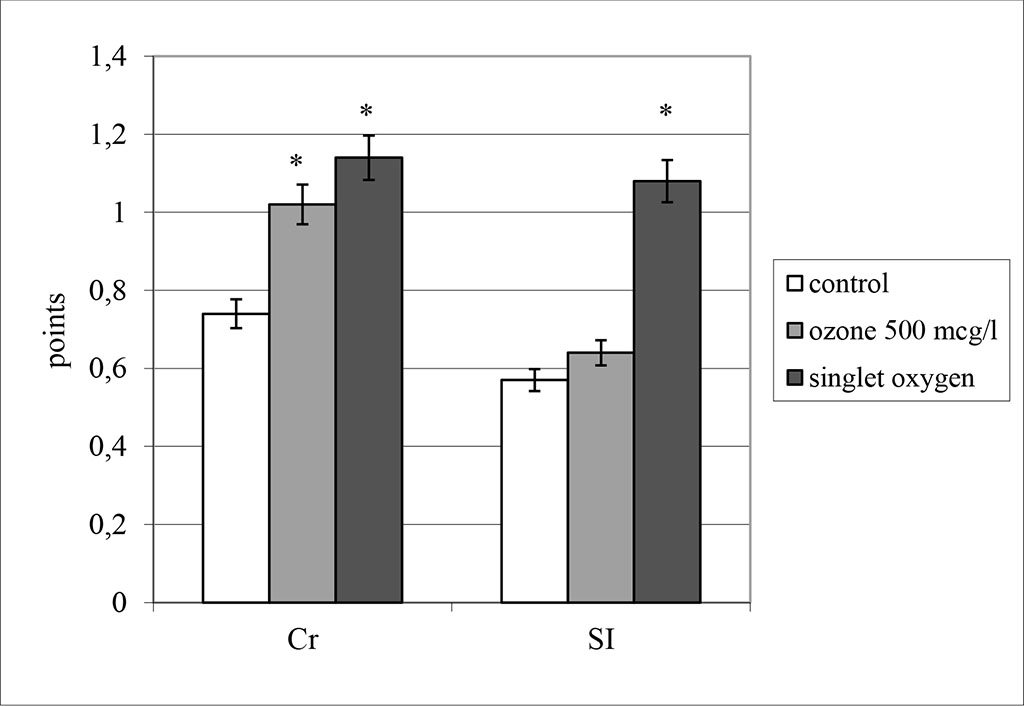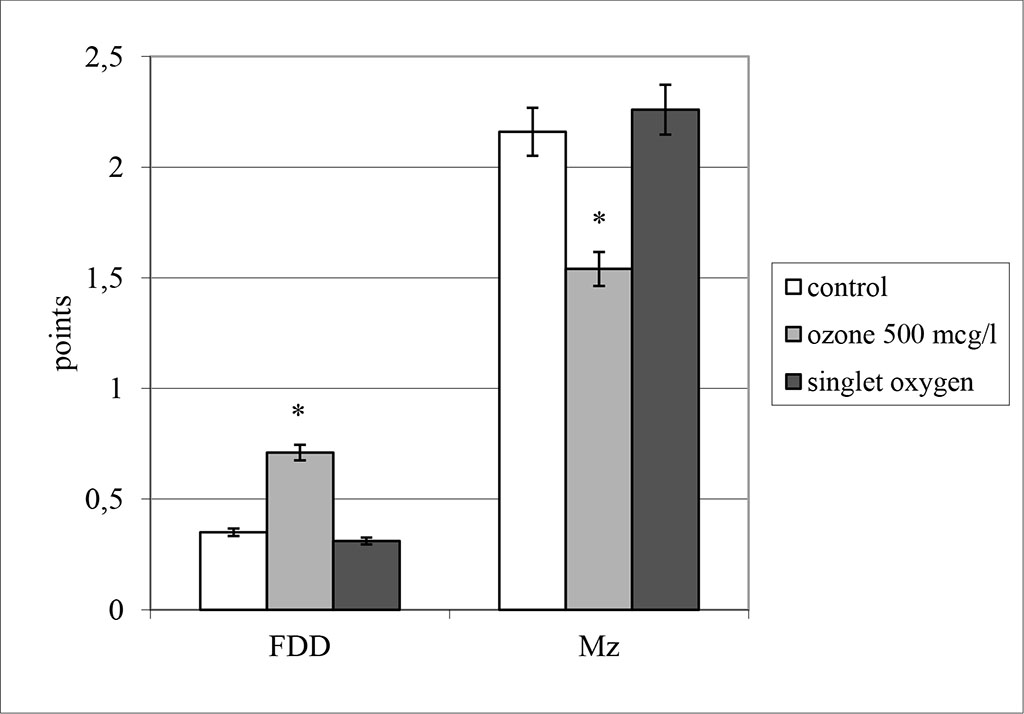- Home
- About the Journal
- Peer Review
- Editorial Board
- For Authors
- Reviewer Recognition
- Archive
- Contact
- Impressum
- EWG e.V.
Cite as: Archiv EuroMedica. 2022. 12; 6: e1. DOI 10.35630/2022/12/6.8
The aim of the study was to assess the effect of reactive oxygen species on the nature of dehydration structuring of blood plasma. The study was performed on 10 whole blood samples of practically healthy volunteers, divided into 3 equal portions. The first one (control) was not manipulated, the second was treated with an ozone-oxygen mixture (ozone concentration – 500 mcg/l), and the third - with a flow from a singlet oxygen generator “Airnergy” (power – 100%). The crystallogenic activity of blood serum was studied by classical crystalloscopy using a system of semi-quantitative indicators. It was stated that the considered reactive oxygen species (ozone and singlet oxygen intermediates) increase the crystallogenic properties of blood plasma, and this effect is more pronounced with respect to the flow from the singlet oxygen generator.
Keywords: singlet oxygen, ozone, blood serum, crystallization, biocrystallomics
Much attention has been paid to the study of the pro- and antioxidant balance of the human and animal body in recent decades [2, 4-8]. One of the intermediate results of these studies was the formation of the concept of "oxidative stress" [2, 7], which is the activation of free radical oxidation, which cannot be compensated by its own antioxidant reserves. The range of means of its correction is not too wide and remains represented only by ozone therapy and antioxidant therapy [4, 5, 7]. In this regard, singlet oxygen generated by biological systems under certain conditions in vivo [4-6, 8], including photobiological processes [1], and also as one of the redox messengers in the implementation of intercellular interactions [1, 4, 6, 8] attracts attention. In this regard, the aim of the study was to assess the effect of reactive oxygen species on the nature of dehydration structuring of blood plasma.
The study was performed on 10 whole blood samples of practically healthy volunteers. The biological fluid was obtained as part of a periodic medical examination. Each sample was divided into 3 equal portions, the first of which (control) was not manipulated, the second was treated with an ozone-oxygen mixture (ozone concentration – 500 mcg/l), and the third with a flow from a singlet oxygen generator “Airnergy” (power – 100%) [4, 5]. The processing time was 3 minutes. After exposure (5 minutes), each portion was centrifuged according to the standard protocol for serum isolation. The crystallogenic activity of blood serum was studied by classical crystalloscopy [3]. The result of dehydration structuring was evaluated using a system of semi-quantitative indicators described by us earlier [3]. The main ones are crystallizability, the structure index, the facia destruction degree and the clearity of the marginal protein zone of the micropreparation. Statistical analysis of the experimental results was performed using the Statistica 6.1 software package.
It has been established that both of the reactive oxygen species have a modulating effect on the crystallogenic properties of the biological fluid, and this effect is specific for the ozone-oxygen mixture and the gas stream initially containing singlet oxygen. Thus, according to the main quantitative parameter of the crystallization of the biological medium – crystallizability – a single trend was registered for the studied factors, consisting in an increase in the density of crystalline elements (Fig. 1). At the same time, the severity of this trend varies. They are more pronounced for singlet oxygen than for ozone-oxygen mixture (+54.0 and +37.8% relative to the control sample, respectively; p<0.05 for both considered effects).
Also, the specificity of the blood plasma response to treatment by various sources of radicals is also realized in relation to the qualitative indicator of the crystalloscopic test – the structure index, which characterizes the complexity of the morphology of crystal figures (Fig. 1). It was revealed that the treatment of biological fluid with an ozone-oxygen mixture does not contribute to the complication of structural elements, whereas the use of a gas stream from a singlet oxygen generator provides a significant increase in the level of the parameter (by 89.5% compared to the control sample, with which no manipulations were performed; p<0.05). Morphologically, these shifts are realized as the detection of single dendritic elements missing in the control facies in the dried micro-preparations of the biological fluid.

Fig. 1. The
effect of ozone and singlet oxygen on the level of crystallizability
(Cr) and the structurу
index (SI) in facies of human blood plasma during in vitro treatment
(* -
statistical significance of differences compared to the control
p<0.05)
The above dynamics of crystallizability and the structure index of blood plasma indicates the general stimulating effect of reactive oxygen species in relation to the crystallogenic properties of the biological fluid, however, it is expressed more clearly when using the gas flow from the singlet oxygen generator.
Additionally, we analyzed the index of the correctness of crystallogenesis (by the facia destruction degree) and the criterion characterizing the state of the biofluid proteome – the clearity of the marginal zone of the micropreparation (Fig. 2). It was shown that only the treatment of the biological medium with an ozone-oxygen mixture contributes to a significant increase in the degree of destruction of facies (2.03 times relative to the control level; p<0.05), and even in this case, the parameter value did not exceed 1 point, which corresponds to moderate destruction of structural elements. On the other hand, the effect on the biological fluid of a gas stream initially containing singlet oxygen did not have a significant effect on this indicator.

Fig. 2. The effect of ozone and singlet oxygen on facia destruction degree (FDD) and the clearity of the marginal zone (Mz) in human plasma facies during in vitro treatment (* - statistical significance of differences compared to the control p <0.05)
Similar shifts were observed with respect to the clearity of the marginal zone of facies of blood plasma (Fig. 2). This indicator, indirectly indicating the amount of native protein in the analyzed biological medium, remains at the initial level when processing a biological object with a stream from the "Airnergy" generator, while the use of an ozone-oxygen mixture leads to a decrease in the relative size of the marginal zone of micro-preparations by 28.7% compared with the control sample (p<0.05). This may be due to the stimulation of oxidative modification of plasma proteins under the action of ozone and its transformation products.
Thus, under in vitro conditions, the considered reactive oxygen species (ozone and singlet oxygen intermediates) increase the crystallogenic properties of blood plasma, and this effect is more pronounced with respect to the flow from the singlet oxygen generator. It should be additionally noted that the latter has a milder effect on the ability of the biological medium to dehydration structuring, since it does not change the level of destruction of elements and retains the size of the marginal facies zone at physiological values.
This research work was supported by the Academic leadership program Priority 2030 proposed by Federal State Autonomous Educational Institution of Higher Education I.M. Sechenov First Moscow State Medical University of the Ministry of Health of the Russian Federation (Sechenov University)